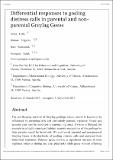Files in this item
Differential responses to gosling distress calls in parental and non-parental Greylag Geese
Item metadata
| dc.contributor.author | Loth, Alina | |
| dc.contributor.author | Frigerio, Didone | |
| dc.contributor.author | Kotrschal, Kurt | |
| dc.contributor.author | Szipl, Georgine | |
| dc.date.accessioned | 2018-11-23T00:49:44Z | |
| dc.date.available | 2018-11-23T00:49:44Z | |
| dc.date.issued | 2018-04 | |
| dc.identifier | 251740253 | |
| dc.identifier | 37a25e53-e352-4de8-b4f0-4e32a2c7c38c | |
| dc.identifier | 85044732671 | |
| dc.identifier.citation | Loth , A , Frigerio , D , Kotrschal , K & Szipl , G 2018 , ' Differential responses to gosling distress calls in parental and non-parental Greylag Geese ' , Journal of Ornithology , vol. 159 , no. 2 , pp. 401-412 . https://doi.org/10.1007/s10336-017-1521-0 | en |
| dc.identifier.issn | 2193-7192 | |
| dc.identifier.uri | https://hdl.handle.net/10023/16532 | |
| dc.description | GS received funding by the Austrian Science Fund (FWF) projects Y-366-B17 and W-1234-G17. AL was funded by the Austrian Federal Ministry of Science, Research and Economy (BMWFW, former BMWF) project SPA/03-005/Graugänse and DF by the Austrian Science Fund (FWF) project P-21489-B17. | en |
| dc.description.abstract | The pre-fledging survival of Greylag goslings (Anser anser) is known to be influenced by parenting style and particularly parental vigilance. Visual and acoustic cues may be important in parental vigilance: if vision is blocked, for example in a highly structured habitat, acoustic recognition of the goslings by their parents would be beneficial. We confronted parental and non-parental Greylag Geese with playbacks of gosling distress calls and analyzed their behavioral responses. Parental geese showed a significant increase in their vigilance behavior during and after playbacks while geese without offspring showed increased comfort behavior. In a permutated discriminant function analysis, we found no family-specific vocal cues in gosling calls, and potential call familiarity did not have any effect on parental behavioral responses. Vigilance in families was further influenced by the number of goslings and gosling age, with increased vigilance when the number of goslings was high, and when goslings were younger. Parental females were more vigilant than parental males, suggesting differences in parental investment between males and females. We conclude that visual cues may be more important in offspring-related vigilance than calls, which elicited different behavioral responses depending on the social class of the geese. | |
| dc.format.extent | 12 | |
| dc.format.extent | 1136138 | |
| dc.language.iso | eng | |
| dc.relation.ispartof | Journal of Ornithology | en |
| dc.rights | © 2017, Dt. Ornithologen-Gesellschaft e.V. . This work has been made available online in accordance with the publisher’s policies. This is the author created, accepted version manuscript following peer review and may differ slightly from the final published version. The final published version of this work is available at https://doi.org/10.1007/s10336-017-1521-0 | en |
| dc.subject | Greylag Geese | en |
| dc.subject | Anser anser | en |
| dc.subject | Distress calls | en |
| dc.subject | Vigilance behavior | en |
| dc.subject | Parental investment | en |
| dc.subject | Acoustic recognition | en |
| dc.subject | QH301 Biology | en |
| dc.subject | NDAS | en |
| dc.subject.lcc | QH301 | en |
| dc.title | Differential responses to gosling distress calls in parental and non-parental Greylag Geese | en |
| dc.type | Journal article | en |
| dc.contributor.institution | University of St Andrews.School of Biology | en |
| dc.identifier.doi | 10.1007/s10336-017-1521-0 | |
| dc.description.status | Peer reviewed | en |
| dc.date.embargoedUntil | 2018-11-23 |
This item appears in the following Collection(s)
Items in the St Andrews Research Repository are protected by copyright, with all rights reserved, unless otherwise indicated.

